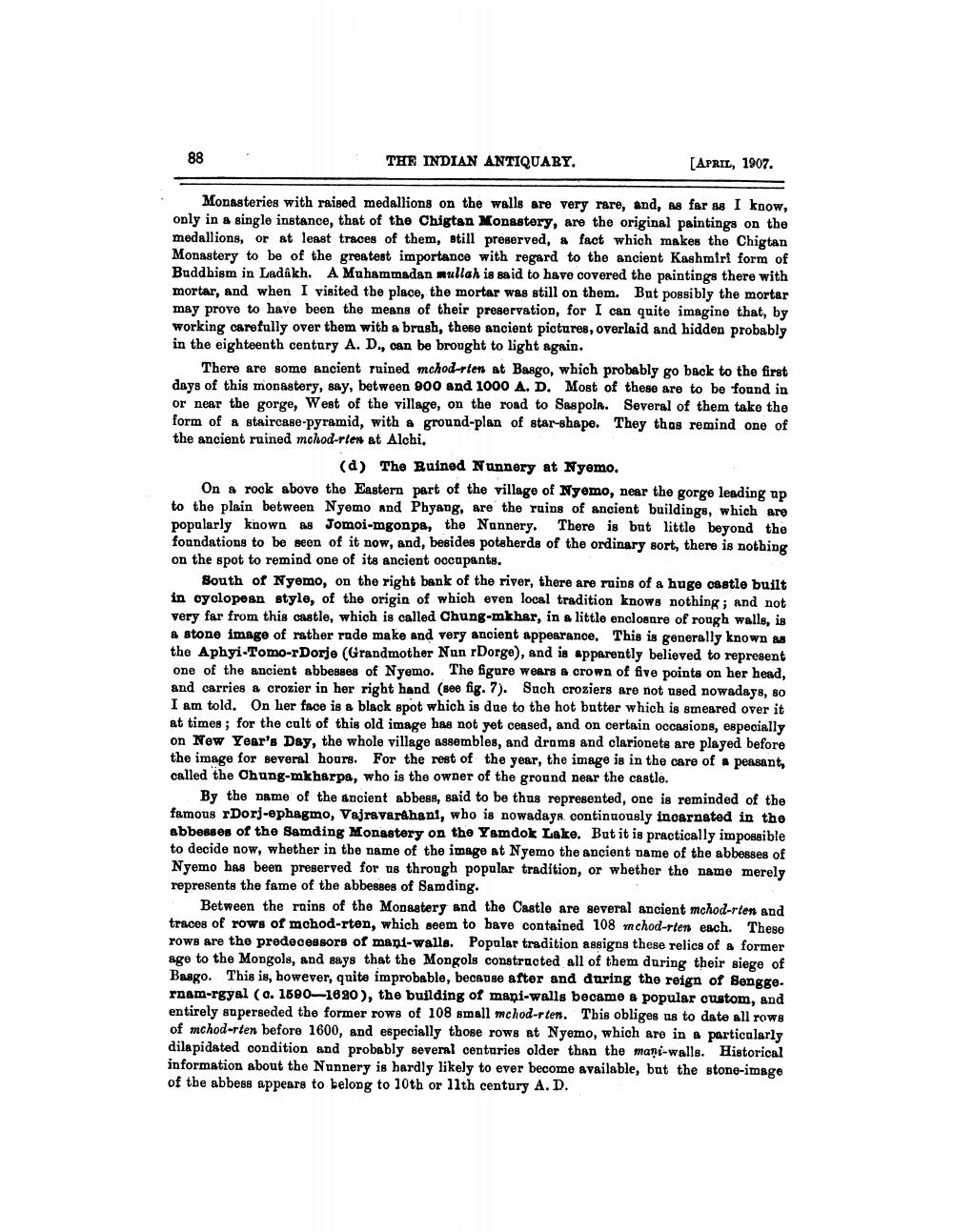________________
88
THE INDIAN ANTIQUARY.
[APRIL, 1907.
Monasteries with raised medallions on the walls are very rare, and, as far as I know, only in a single instance, that of the Chigtan Monastery, are the original paintings on the medallions, or at least traces of them, still preserved, a fact which makes the Chigtan Monastery to be of the greatest importance with regard to the ancient Kashmiri form of Buddhism in Ladakh. A Muhammadan mullah is said to have covered the paintings there with mortar, and when I visited the place, the mortar was still on them. But possibly the mortar may prove to have been the means of their preservation, for I can quite imagine that, by working carefully over them with a brush, these ancient pictures, overlaid and hidden probably in the eighteenth century A. D., can be brought to light again.
There are some ancient ruined mchod-rten at Bango, which probably go back to the first days of this monastery, say, between 900 and 1000 A. D. Most of these are to be found in or near the gorge, West of the village, on the road to Saspola. Several of them take the form of a staircase-pyramid, with a ground-plan of star-shape. They thos remind one of the ancient ruined mchod-rien at Alohi.
(d) The Ruined Nunnery at Nyemo. On & rock above the Eastern part of the village of Nyomo, near the gorge leading up to the plain between Nyemo and Phyang, are the ruins of ancient buildings, which are popularly known as Jomoi-mgonpa, the Nunnery. There is but little beyond the foundations to be seen of it now, and, besides potsherds of the ordinary sort, there is nothing on the spot to remind one of its ancient oocupante.
South of Nyemo, on the right bank of the river, there are ruins of a huge castle built in oyclopean style, of the origin of which even local tradition knows nothing; and not very far from this castle, which is called Chung-mkhar, in a little enclosure of rough walls, is A stone image of rather rude make and very ancient appearance. This is generally known as the Aphyi-Tomo-rDorje (Grandmother Nan Dorge), and is apparently believed to represent one of the ancient abbesses of Nyemo. The figure wears a crown of five points on her head, and carries a crozier in her right hand (see fig. 7). Such croziers are not used nowadays, 80 I am told. On her face is a black spot which is due to the hot butter which is smeared over it at times; for the cult of this old image has not yet ceased, and on certain occasions, especially on New Year's Day, the whole village assembles, and drams and clarionets are played before the image for several hours. For the rest of the year, the image is in the care of a peasant, called the Chung-mkharpa, who is the owner of the ground near the castle.
By the name of the ancient abbess, said to be thus represented, one is reminded of the famous rDorj-ephagmo, Vajravardhani, who is nowadays. continuously incarnated in the abbesses of the Samding Monastery on the Yamdok Lake. But it is practically impossible to decide now, whether in the name of the image at Nyemo the ancient name of the abbesses of Nyemo has been preserved for us through popular tradition, or whether the name merely represents the fame of the abbesses of Samding.
Between the ruins of the Monastery and the Castle are several ancient mchod-rten and traces of rows of mchod-rten, which seem to bave contained 108 mchod-rten each. These rows are the predecessors of mani-walls. Popular tradition assigns these relics of a former age to the Mongols, and says that the Mongols constructed all of them during their siege of Basgo. This is, however, quite improbable, because after and during the reign of Sengge. rnam-rgyal (0.1600--1620 ), the building of mani-walls became a popular custom, and entirely superseded the former rows of 108 small mchod-r ten. Tbis obliges us to date all rows of mchod-rten before 1600, and especially those rows at Nyemo, which are in a particularly dilapidated condition and probably several centuries older than the mani-walls. Historical information about the Nunnery is hardly likely to ever become available, but the stone-image of the abbess appears to belong to 10th or 11th century A. D.




